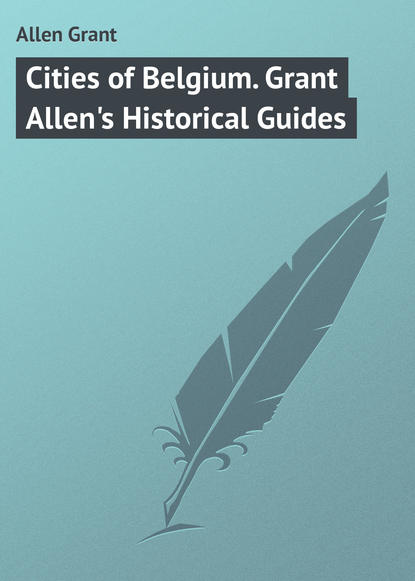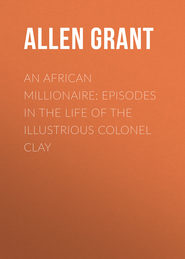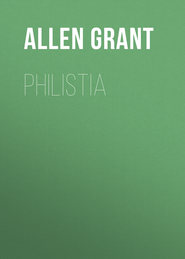По всем вопросам обращайтесь на: info@litportal.ru
(©) 2003-2024.
✖
Cities of Belgium. Grant Allen's Historical Guides
Настройки чтения
Размер шрифта
Высота строк
Поля
293. Rembrandt: **Admirable portrait of his wife, Saskia; almost a replica of the one at Cassel, perhaps either painted by a pupil, or else from memory after her death, and badly restored. It breathes Dutch modesty.
349. Terburg: *Girl playing a mandoline.
705. Excellent *portrait of a Burgomaster, by Rembrandt.
324. A charming Schalken.
628. Unknown: perhaps Frans Hals: Excellent portrait of a calm old lady.
668. Karel du Jardin: Admirable landscape, with cows.
188. Celebrated and vigorous **Fisher-boy of Haarlem, with a basket, by Frans Hals, rapidly touched with the hand of a master.
339. One of Jan Steen’s village merry-makings.
26. Delicate soft landscape, by J. and A. Both.
675. A mill, by Hobbema.
768. Van der Velde: Fine landscape, with cows.
427. Flowers by Van Huysum.
674. Admirable *portrait, by Frans Hals, of a round-faced, full-blooded, sensuous Dutch gentleman. Full of dash and vigour.
738. Venus and Cupid, by W. van Mieris.
437. Excellent fishmonger, by W. van Mieris.
466. *The Smoker, by A. van Ostade.
682. Arch and charming portrait, by Mytens.
773. A fine Wynants.
382. B. van der Helst: Child with a dog.
679. Some of Molenaer’s peasant folk.
713. Ruysdael: *Waterfall in Norway.
The room is full of other fine and delicately-finished pictures of the Dutch School, of which I say nothing, only because they are of the kind which are to be appreciated by careful examination, and which do not need explanation or description.
Room K. contains Flemish works of the later School of Rubens and the beginning of the decadence.
The remaining rooms of the Gallery have modern pictures, belonging to the historical and to the archaic Schools of Antwerp. These works lie without the scope of the present Guides, but many of them are of the highest order of merit, and they well deserve attention both for their own intrinsic excellence and for comparison with the works of the 15th and early 16th centuries on which they are based. The paintings of Leys and his followers, mainly in Room T, are especially worth consideration in this connection. These painters have faithfully endeavoured to revert to the principles and methods of the great early Flemish Masters, and though their work has often the almost inevitable faults and failings of a revival, it cannot fail to interest those who have drunk in the spirit of Van Eyck and Memling.
On the ground floor, a good copy, 413, etc., of the Adoration of the Lamb at Ghent, useful for filling up the gaps in your knowledge, and more readily inspected at leisure and from a nearer point of view than the original. The portraits and battle scenes on the remaining walls need little comment.
D. THE TOWN IN GENERAL
[Mediæval Antwerp, now no more, lay within a narrow ring of walls in the neighbourhood of the Cathedral. Its circumference formed a rough semi-circle, whose base-line was the Schelde, while its outer walls may still be traced on a good map about the Rempart Ste. Catherine and the Rempart du Lombard. This oldest district still remains on the whole an intricate tangle of narrow and tortuous streets, with a few ancient buildings. Later Renaissance Antwerp stretched to the limit of the existing Avenues in their northern part, though the southern portion (from the Place Léopold on) extends beyond the boundary of the 17th century city, and occupies the site of the huge demolished Old Citadel, built by Alva. Antwerp, however, has undergone so many changes, and so few relics of the mediæval age now survive, that I can hardly apply to its growth the historical method I have employed in other Belgian towns. It will be necessary here merely to point out the principal existing objects of interest, without connecting them into definite excursions.]
The centre of mediæval Antwerp was the Grand’ Place, which may be reached from the Place Verte, through the little triangular Marché aux Gants, in front of the main façade of the Cathedral. It was, however, so entirely modernized under the Spanish régime that it now possesses very little interest. The W. side of the square is entirely occupied by the Hôtel-de-Ville, a poor Renaissance building, which looks very weak after the magnificent Gothic Town Halls of Bruges, Ghent, Brussels, and Louvain. The façade is extremely plain, not to say domestic. The ground floor has an arcade in imitation of Italian rustica work, above which come two stories with Doric and Ionic columns (and Corinthian in the centre); the top floor being occupied by an open loggia, supporting the roof. In the centre, where we might expect a spire, rises a false gable-end, architecturally meaningless. The niche in the gable is occupied by a statue of Our Lady with the Child (1585), the patroness of the city, flanked by allegorical figures of Wisdom and Justice.
The interior has been modernized: but it contains one fine hall, the Salle Leys, decorated with noble archaistic paintings by Baron Leys. It may be visited before 9, or after 4 in the evening (1 franc to the concierge). In the Burgomaster’s Room is also a good Renaissance chimney-piece, from the Abbey of Tongerloo, with reliefs of the Marriage at Cana, the Brazen Serpent, and Abraham’s Sacrifice.
The square contains a few Guild Houses of the 17th century, the best of which is the Hall of the Archers, to the R. of the Hôtel-de-Ville, a handsome and conspicuous building, lately surmounted by a gilt figure of St. George slaying the Dragon, in honour of the patron saint of the Archers. The older Guild Houses, however, were mostly destroyed by the Spaniards. The square, as it stands, being Renaissance or modern, cannot compare with the Grand’ Place in most other Belgian cities.
The centre of the Place is occupied by a bronze fountain, with a statue of Silvius Brabo, a mythical hero of mediæval invention, intended to account for the name Brabant. He is said to have cut off the hand of the giant Antigonus, who exacted a toll from all vessels entering the Schelde, under penalty of cutting off the hand of the skipper, – a myth equally suggested by a false etymology of Antwerp from Hand Werpen (Hand throwing). The Hand of Antwerp, indeed, forms part of the city arms, and will meet you on the lamp-posts and elsewhere. It is, however, the ordinary Hand of Authority (Main de Justice), or of good luck, so common in the East, and recurring all over Europe, as on the shields of our own baronets. Such a hand, as an emblem of authority, was erected over the gate of many mediæval Teutonic cities.
One of the objects best worth visiting in Antwerp, after the Cathedral and the Picture Gallery, is the Plantin-Moretus Museum containing many memorials of a famous family of Renaissance printers, whose monuments we have already seen in the Cathedral. To reach it you turn from the Place Verte into the Rue des Peignes, almost opposite the S. door of the Cathedral. The second turning to the R. will lead you into the small Place du Vendredi, the most conspicuous building in which is the Museum.
Beyond advising a visit, it is difficult to say much about this interesting old house and its contents. Those who are lovers of typography or of old engravings will find enough in it to occupy them for more than one morning. Such had better buy the admirable work, Le Musée Plantin-Moretus, by M. Max Rooses, the conservator. On the other hand, the general sight-seer will at least be pleased with the picturesque courtyard, draped in summer by the mantling foliage and abundant clusters of a magnificent old vine, as well as with the spacious rooms, the carved oak doorways, balustrades, and staircases, the delicious galleries, the tiles and fireplaces, and the many admirable portraits by Rubens or others. Were it merely as a striking example of a Flemish domestic interior of the upper class during the Spanish period, this Museum would well deserve attention. Read the following notes before starting.
The house of Plantin was established by Christopher Plantin of Tours (born 1514), who came to Antwerp in 1549, and established himself as a printer in 1555. He was made Archetypographer to the King by Philip II., and the business was carried on in this building by himself, his son-in-law, Moretus, and his descendants, from 1579 till 1875. It was Plantin’s daughter, Martina, who married John Moretus (see the Cathedral), and under the name of Plantin-Moretus the business was continued through many generations to our own day. The firm were essentially learned printers, setting up works in Latin, Greek, and Hebrew, or even in Oriental types, and issuing editions of many important classical authors. I will not describe the various rooms, about which the reader can wander for himself at his own sweet will, but will merely mention that they contain admirable portraits of the Plantin and Moretus families, and of their famous editor, Justus Lipsius, by Rubens, and others. (The Lipsius is particularly interesting for comparison with the one at Florence in the Pitti.) The dwelling-rooms and reception-rooms, of the family, with their fine early furniture, are now open to the visitor. So is the quaint little shop, facing the street, the composing room and proof-readers’ room, the study occupied by Lipsius, and the library, with examples of many of the books printed by the firm. The original blocks of their woodcuts and of their capital letters, with the plates of their engravings, are likewise shown, together with old and modern impressions. Do not suppose from this, however, that the place is only interesting to book-hunters or lovers of engravings. The pictures and decorations alone, – nay, the house itself – will amply repay a visit.
A walk should be taken from the Place Verte, by the Vieux Marché au Blé, or through the Marché aux Gants, to the river front and Port of the Schelde. (Follow the tram-line.) Here two handsome raised promenoirs or esplanades, open to the public, afford an excellent *view over the river, the old town, and the shipping in the harbour.
The southernmost (and pleasantest) of these promenoirs ends (S.) near the Porte de l’Escaut, a somewhat insignificant gateway, designed by Rubens, and adorned with feeble sculpture by Arthus Quellin. It stood originally a little lower down the river, but has been removed, stone by stone, to its present situation. The quaint red building, with hexagonal turrets at the angles, visible from both esplanades, is the Vieille Boucherie, or Butchers’ Guild Hall, of 1503. It stands in a squalid quarter, but was once a fine edifice. Near the N. end of this promenoir, a ferry-boat runs at frequent intervals to the Tête-de-Flandre on the opposite shore of the river. Here there is a Kursaal and a strong fort. It is worth while crossing on a fine day in order to gain a general view of the quays and the town. The northernmost promenoir is approached by an archway under the castellated building known as the Steen. This is a portion of the old Castle of Antwerp, originally belonging to the Margraves and the Dukes of Brabant, but made over by Charles V. to the burghers of Antwerp. The Inquisition held its sittings in this castle. It is now, though much restored and quite modern-looking (except the portal), almost the only remaining relic of Mediæval Antwerp, outside the Cathedral. It contains a small Museum of Antiquities (unimportant; open daily, 10 to 4: 1 fr.: Sunday and Thursday free). Unless you have plenty of time you need not visit it.
A little way beyond the N. end of the northern promenoir a tangled street leads to the Church of St. Paul, which will be described hereafter. Continuing along the Quays in this direction you arrive at last at the Docks. The large modern castellated building in front of you is the Pilotage, round which sea-captains congregate in clusters. Turning along the dirty quay to the R., you reach shortly on the L. the site of the Maison Hanséatique, which was the entrepôt in Antwerp of the Hanseatic League. But it was burnt down a few years since, and its place is now occupied by mean sheds and warehouses. All this quarter is given over to the most unsightly and malodorous realities of modern seafaring life and commerce.
Antwerp is somewhat ill provided with drives or country walks. The prettiest of its public gardens is the little Park, which may be reached from the Avenue des Arts by either of the three main Avenues eastward, adorned respectively with statues of Quentin Matsys, Leys, and Jordaens. The Park is a small but ingeniously laid out triangular area, occupying the site of an old bastion, with a pleasing sheet of ornamental water (originally the moat), crossed by a bridge, and backed up by the twin spires of the modern Church of St. Joseph. Around it lies the chief residential quarter of 19th century Antwerp. This is a cool stroll in the afternoon, for one tired of sight-seeing. (Ask your hotel porter when and where the band plays daily.) Further on in the same direction is the pretty little public garden known as the Pépinière, and lying in a pleasant open quarter. (Band here also.)
The Zoological Garden, just behind the Gare de l’Est, (admission 1 fr.) is well worth a visit if you are making a stay. It is particularly well stocked with birds and animals, and has a rather pretty alpine rock-garden. On Sunday afternoons, a good band plays here from 3 to 6, and all Antwerp goes to listen to it.
A round of the Avenues may best be made in an open tram. The northern portion, leading from the Entrepôt and the Goods Station as far as the Place de la Commune, has few objects of interest. In the Place de la Commune you pass, R., the handsome and ornate Flemish Theatre; while, L., the Rue Carnot leads to the Zoological Garden, and to the uninteresting industrial suburb of Borgerhout. Beyond this comes a Covered Market, L., and then the Place Teniers, with a statue of Teniers. Here the Avenue de Keyser leads, L., to the main Railway Station (Gare de l’Est). Further on, L., the Avenue Marie-Thérèse, with a statue of Matsys, runs to the Park. So, a little later, do the Avenue Louise-Marie, with a statue of Leys, and the Avenue Marie-Henriette, with a statue of Jordaens. The handsome building, with domed and rounded turrets, on your R., just beyond the last-named Avenue, is the Banque Nationiale, intended to contain the public treasure of Belgium in case of war. Here the Chaussée de Malines leads off, S.E., to the uninteresting suburb of Berchem. The heavy new building on the L., a little further S., looking like a French mediæval château, is the Palais de Justice. From this point the Avenue du Sud runs through an unfinished district, occupying the site of the old Citadel (Alva’s) past the Museum and the Palais de l’Industrie, to the desolate Place du Sud, with the South Railway Station. You can return by tram along the Quays to the Hôtel-de-Ville and the Cathedral.
If you have plenty of time to spare, you may devote a day to
The Rococo Churches
Most of the Antwerp churches, other than the Cathedral, are late Gothic or Renaissance buildings, disfigured by all the flyaway marble decorations so strangely admired during the 17th and 18th centuries. Few of them deserve a visit, save for a picture or two of Rubens still preserved on their altars. There are one or two, however, usually gone through by tourists, and of these I shall give some brief account, for the benefit of those who care for such things, though I do not think you need trouble about them, unless you have plenty of time, and are specially attracted by the later School of Antwerp.
The most important of these rococo churches is St. Jacques, the principal doorway of which opens into the Longue Rue Neuve. The pleasantest way to reach it, however, is to go from the Place Verte through the Marché aux Souliers, following the tramway to the Place de Meir. This broad street (one of the few open ones in Antwerp), lined by baroque Renaissance mansions of some pretensions, has been formed by filling up an old canal. The most imposing building on the R., marked by two angels holding an oval with the letter L. (the king’s initial), is the Royal Palace. A little further on, upon the same side of the street, is the House of Rubens’s Parents, with his bust above, and an inscription on its pediment signifying the fact in the Latin tongue. To reach St. Jacques you need not go quite as far down the street as these two buildings. Turn to your L. at the Bourse, a handsome modern edifice, standing at the end of what looks like a blind alley. The road runs through it, and it is practically used as a public thoroughfare. The building itself is recent – 1869-72 – but it occupies the site of a late-Gothic Exchange of 1531, erected by Dominic van Waghemakere. The present Bourse resembles its predecessor somewhat in style, but is much larger, has an incongruous Moorish tinge, and is provided with a nondescript glass-and-iron roof. Turn to the R. at the end of the lane, and continue down the Longue Rue Neuve, which leads you towards St. Jacques, a late-Gothic church, never quite completed. The entrance is not by the façade, but on the S. side, in the Longue Rue Neuve. (Visitors admitted from 12 till 4 p.m., 1 fr. per person. Knock at the door, and the sacristan will open.)
The interior is of good late-Gothic architecture, terribly over-loaded with Renaissance tombs and sprawling baroque marble decorations. The church was used as the Pantheon (or Westminster Abbey) for burials of distinguished Antwerp families under the Spanish domination; and they have left in every part of it their ugly and tasteless memorials.
Begin in the S. Aisle.
1st chapel. Van Dyck: St. George and the Dragon: mediocre. Above, statue of St. George, to whom angels offer crowns of martyrdom. Good modern marble reliefs of Scenes from the Passion, continued in subsequent chapels.
At the end, Baptistery, with good font.
2nd chapel, of St. Antony. Temptation of St. Antony, by M. De Vos. Italian 17th century Madonna.
3rd chapel, of St. Roch, the great plague-saint. It contains an altar-piece by E. Quellin, angels tending St. Roch when stricken with the plague. Above, the saint with his staff and gourd, in marble, accompanied by the angel who visited him in the desert. On the window wall, relics of St. Roch, patron against the plague. Round this chapel and the succeeding ones are a series of pictures from the Life of St. Roch, by an unknown Flemish master, dated 1517. They represent St. Roch in prison; relieved by the dog; resting in the forest; visited by the angel; etc. (See Mrs. Jameson.) A tomb here has a good Virgin and Child.











